Keywords
|
| Mobile WiMAX, Quality of Service, Bandwidth request, Scheduling |
INTRODUCTION
|
| Future generation networks will be characterized by variable and high data rates, quality of services (QoS) and seamless mobility. An important aspect in a next generation global network is standardization to allow vendor independence and interoperability. The 802.16 standard (WiMAX– Worldwide Interoperability for Microwave Access) is developed by IEEE to fulfil the requirements of next generation wireless networks. WiMAX has witnessed a tremendous growth and evolved as one among the potential broadband wireless access (BWA) technology and designed to achieve goals like easy deployment, high speed data rate, large spanning area and large frequency spectrum. The IEEE 802.16e standard [1-2] introduces the mobility to WiMAX and a user can access the network ubiquitously. |
| The mobile WiMAX (802.16e standard) is designed to support seamless mobility while maintaining differentiated QoS [1-2]. The standard supports QoS by classifying services into different service types. The service types in 802.16e have been designed to support real time applications like voice, video and non-real time application like file transfer. The service types defined in WiMAX are Unsolicited Grant Service (UGS), Extended Real-time Polling Service (ertPS), Real-time Polling Service (rtPS), Non-Real-time Polling Service (nrtPS) and Best Effort (BE). The specifications for these service types such as minimum reserved rate, maximum sustained rate, maximum latency, tolerated jitter, traffic priority etc are defined in the standard, but the standard does not specify any scheduling architecture. |
| Among various resources for wireless communications, bandwidth is the most precious resource due to its scarcity and medium-sharing properties [3]. In order to enhance the efficiency of the bandwidth with QoS provision, the mobile WiMAX system adopts well-organized bandwidth request, grant and polling mechanisms. Bandwidth allocation is governed by the Base Station (BS), the downlink bandwidth is solely managed by the downlink scheduler at the BS, but the uplink bandwidth is allocated by BS to Subscriber Stations (SSs) through the resource request and grant process. In this paper a bandwidth request mechanism for ertPS, rtPS and nrtPS is proposed to enhance the QoS performance of WiMAX network. In the proposed bandwidth request mechanism the SS requests for the additional bandwidth for service flows by considering the round trip delay incurred during the bandwidth request grant process. The rest of this paper is organized as follows. Section 2 outlines the related work in the literature. Section 3 discusses the bandwidth request/grant mechanism in WiMAX. In Section 4 proposed bandwidth request mechanism is described. Section 5 discusses the simulation results followed by conclusion in section 6. |
RELATED WORK
|
| Many researchers have worked on bandwidth request/grant mechanism in WiMAX. In [4], an adaptive polling scheme for ON/OFF traffic has been proposed to improve the bandwidth utilization for unicast polling. In [5], authors have discussed uplink and downlink packet schedulers for bandwidth allocation process and admission control for QoS. A Markov chain (MC) model for unicast polling is proposed in [6]. In [7] the authors compared the performance obtained with the contention-based mechanism and that with connections being polled in a round-robin manner. Their results show that contention resolution is more efficient than individual polling, in terms of the resources consumed by the bandwidth request process. In [8], the performance of the random access protocol of IEEE 802.16e has been studied via an M/G/1 model of the system. The paper [9] compares random access vs. polling bandwidth request mechanisms, also scheduling algorithms are proposed to optimize the delay and target bandwidth utilization respectively. The papers [10-11] present an analytical model for the contention-based bandwidth request scheme of WiMAX. Also this model is used to calculate the capacity of the contention slots in delivering bandwidth requests, from which the average access delay is also found. These measures are used to determine a proper configuration for the efficient operation of the contention-based bandwidth request scheme. Authors of paper [12] proposed bandwidth scheduling algorithm at SS for rtPS, wherein the SS predicts the arrival of rtPS packets prior to the arrival and requests the BS for bandwidth in advance. Authors of [13] investigated the impact of bandwidth request/grant schemes on BE traffic. In [14] the polling mechanisms in IEEE 802.16 networks are investigate, also a polling mechanism is proposed to optimize the performance. |
BANDWIDTH REQUEST/GRANT MECHANISM IN WIMAX
|
| A single cell in WiMAX consists of a BS and multiple SSs. In Point to Multipoint (PMP) mode, the BS schedules the traffic flow for SSs and SSs do not communicate directly. The communication between BS and SS are bidirectional i.e., downlink (from BS to SS) and uplink (from SS to BS). The downlink channel is in broadcast mode and the uplink channel is shared by various SS’s through Time Division Multiple Access (TDMA) manner. The standard supports Time Division Duplex (TDD) mode, in which each TDD frame consists of downlink and uplink subframes. The downlink subframe has downlink map (DL map) and uplink map (UL map). The DL map contains information about the duration of subframes and which time slot belongs to a particular SS as the downlink channel and UL map consists of information element (IE) which includes transmission opportunities. |
| In order to enhance the efficiency of the bandwidth usage while supporting the QoS provision, the mobile WiMAX system adopts well-organized bandwidth request, grant and polling mechanisms, which are supported by the five different types of scheduling services. When an uplink connection has data to send, its SS sends a bandwidth request message to BS. The SS requests for the bandwidth on a per connection basis and gets the aggregate bandwidth allocated to all its services, which is typically a Grant per Subscriber Station (GPSS) type of bandwidth grant. |
| A. Requests |
| Request refers to the mechanism in which the SS informs the BS that it needs uplink bandwidth allocation. Request is normally made on a stand-alone bandwidth request signalling but, optionally, it may be made as a piggyback on an uplink data burst. As uplink burst profile changes dynamically, request is made in terms of the number of bytes needed to carry the MAC header and payload, excluding the PHY overhead. The bandwidth request message may be transmitted during any uplink allocation, except for the initial ranging interval. Piggyback bandwidth request and bandwidth stealing are allowed for all the service types except UGS. |
| Request may be incremental or aggregate. If it is an incremental request, the BS adds the requested bandwidth to the current bandwidth of the connection; and if it is aggregate request, the BS replaces the current bandwidth of the connection with the newly requested bandwidth. The request type is indicated on the type field in the bandwidth request header. The capability of incremental request is optional for SS and mandatory for BS, whereas the capability of aggregate request is mandatory for both SS and BS. |
| B. Grants |
| Each bandwidth request of the SSs reference individual connections, each bandwidth grant is addressed to the SSs’ basic Connection Identifiers (CID), not to individual CIDs. Usually bandwidth grant takes a nondeterministic pattern, so some SSs may happen to get less frequent grants than expected. Thus the SSs should be prepared to perform backoff and repeat requests based on the latest information received from the BS. |
| C. Polling |
| Polling refers to the process that the BS allocates bandwidth to the SSs for making bandwidth requests. Such an allocation may be done to individual SSs or to a group of SSs. In the latter case, bandwidth request contention gets involved among the multiple SSs in the groups. The allocation is done not in an explicit message form but as a series of IEs within the UL-MAP. Polling is done on an SS basis as was the case for bandwidth allocation, while bandwidth request is done on a CID basis. When unicast polling is made on an SS individually, no explicit message is needed to poll the SS. The Table 1 gives the classification of scheduling services and their polling method. |
PROPOSED BANDWIDTH REQUEST MECHANISM
|
| In this paper a bandwidth request mechanism is proposed, wherein the SS request for additional bandwidth by estimating the packets that may arrive during the bandwidth request grant process along with the bandwidth for already arrived packets. In contrast, in the basic bandwidth request mechanism the SS sends a bandwidth request only for the packets already arrived. |
| In WiMAX system the scheduler at SS makes the bandwidth requests for ertPS/rtPS/nrtPS connections for data transmission. In response to the request by SS, the BS will provide bandwidth equal to or less than the requested bandwidth based on availability. The bandwidth requested at a particular instant depends on the total bytes in the queue of service flows. The time required by the BS to grant the bandwidth to the SSs after receiving the bandwidth requests is depend on the BS allocation mechanism and number of active SSs. Hence in the bandwidth request-grant process there may be a considerable delay (Treq −grant ), during which new data packets may arrive in the service flow queue. The SS has to send fresh bandwidth request for this new set of data, which might have arrived during interval, this may also lead to additional delay. In order to overcome this delay, in the proposed bandwidth request mechanism, the SS estimates the data that may arrive during (Treq −grant ) interval, before making the bandwidth request for the service flow. Then the SS requests for the additional bandwidth for estimated packets along with bandwidth required for already arrived packets. The Fig. 1 demonstrates the flowchart of proposed bandwidth request mechanism. Part of the flowchart embedded in solid line is basic mechanism and with dotted line covers the proposed improvement to the basic mechanism. |
| A. Data Estimation |
| Let at time t1 the SS requests for bandwidth for a service flow and at time t2 the BS grants the bandwidth. Then the Treq −grant interval is given in the equation 1. |
 (1) (1) |
| In order to estimate the amount of data arrived during the Treq −grant interval, the proposed algorithm considers the maximum sustained rate of the service flow. Let M be the maximum sustained rate of a service flow, which defines the peak information rate (bps) of the service. The average number of data bytes arrived (BAestimated ) in the time duration Treq −grant is given by the equation 2, |
 (2) (2) |
| The SS requests for the additional bandwidth required for the BAestimated along with bandwidth required for data bytes already in the queue. |
SIMULATION AND RESULTS
|
| The performance of proposed bandwidth request mechanism is evaluated through simulation using QualNet 5.2 simulator [15]. A single WiMAX cell is considered in the simulation area of 2Km x 2Km working at a frequency 2.4 GHz. The path loss model selected is two-ray with constant shadowing model of shadowing mean 4dB. The simulation parameters considered are mentioned in Table 2. |
| A. Scenario 1 |
| In this scenario a WiMAX cell consisting of single BS and 10 SSs is considered. This scenario is designed to study the performance of proposed bandwidth request mechanism for a single SS. The Fig. 2 and Fig. 3 give the system modeling of scenario 1 and snapshot of scenario 1 respectively. The SS1 (SS under study) is made to transmit 5 traffics each are mapped to UGS, ertPS, rtPS, nrtPS and BE to SS2. The data rate considered for UGS and ertPS is 64Kbps, for rtPS and nrtPS is 512Kbps and FTP is considered for BE services. In order to create contention other SSs are made to transmit 5 CBR traffic mapped to UGS (Fig. 2). The simulation studies have been carried out for proposed bandwidth request mechanism and basic bandwidth request mechanism by considering throughput and delay of real time services and non real time services as the performance metrics. |
| Fig. 4 and Fig. 5 give the bandwidth requested by the SS under study and bandwidth grants received respectively with respect to simulation time. It is observed from the Fig. 4 that the bandwidth requested by proposed mechanism is more compared to basic mechanism, as the SS requests for extra bandwidth in proposed mechanism. From the Fig. 5 it is evident that the SS receives additional bandwidth grants in proposed mechanism compared to basic mechanism. |
| Fig. 6 and Fig. 7 show the throughput performance of real time services and non-real time services respectively with respect to simulation time. It is observed from Fig. 6 and Fig. 7 that the throughput performance of both real time and non real time services for proposed mechanism is substantially improved compared to basic mechanism, as the SS is granted with additional bandwidth in proposed mechanism. |
| Fig. 8 and Fig. 9 give the delay performance of real time and non-real time services respectively with respect to simulation time. Fig. 8 and Fig. 9 depict that the delay performance for proposed mechanism is better compared to basic mechanism, as the SS requests for additional bandwidth by estimating arrival of packets during bandwidth request-grant time interval, the delay encountered by the packets arrived during the bandwidth request-grant time interval is less in proposed mechanism and this interval is considerable. |
| B. Scenario 2 |
| In this scenario the design of scenario 1 is retained and the aggregate data rate of ertPS, rtPS and nrtPS connections of SS under study are varied from 2Mbps to 20Mbps insteps of 2Mbps. Throughput and delay performances of real time services and non real time services are considered as the performance metrics. |
| Fig. 10 and Fig. 11 give the throughput performance of real time and non-real time services respectively for varying data rate. It is observed from the Fig. 10 and Fig. 11 that for lesser data rates, the throughput performances of both basic and proposed algorithms are almost same. For higher data rates the throughput performances of proposed algorithm are substantially better compared to the basic algorithm, since in proposed algorithm the SS receives additional bandwidth. |
| Fig. 12 and Fig. 13 give the delay performance of real time and non-real time services for varying data rate respectively. It is observed from the Fig. 12 and Fig. 13 that the delay performance of proposed algorithm is much better compared to basic algorithm, since in the proposed algorithm, the packets arrived during bandwidth request-grant time interval are served along with packets already arrived while making the bandwidth request. |
CONCLUSION
|
| In IEEE 802.16e WiMAX networks, bandwidth request–grant schemes are employed for reducing data collision and supporting various QoS requirements. The SS sends bandwidth request messages to the BS and the BS grants bandwidth according to the available bandwidth. In this paper a bandwidth request mechanism for ertPS, rtPS and nrtPS is proposed to enhance the QoS performance of WiMAX network. The proposed algorithm is implemented using QualNet simulator. The performance of proposed bandwidth request mechanism is evaluated through simulation and is compared with the basic algorithm. The simulation results show that the performance of proposed algorithm is much better compared to basic algorithm. |
| |
Tables at a glance
|
 |
 |
| Table 1 |
Table 2 |
|
| |
Figures at a glance
|
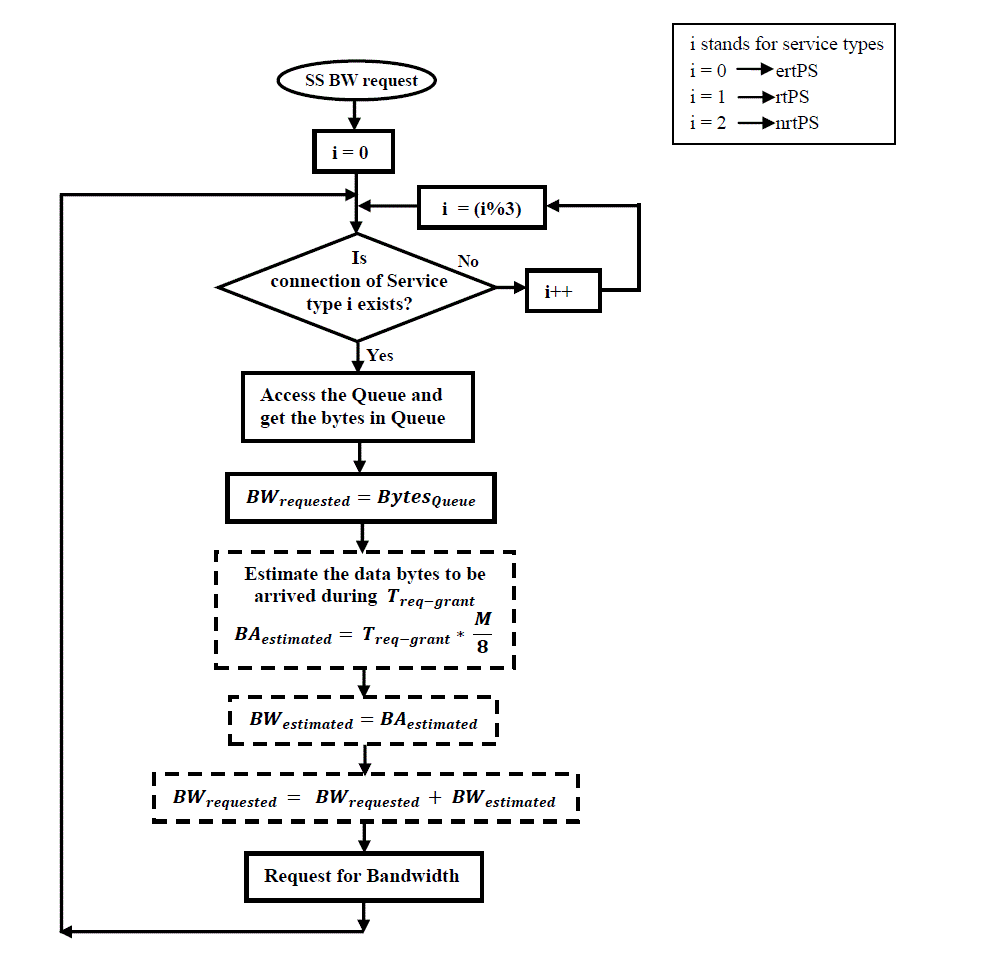 |
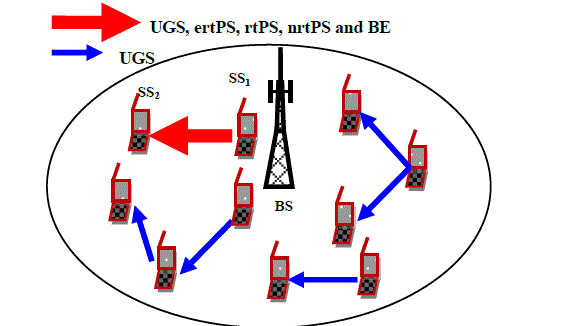 |
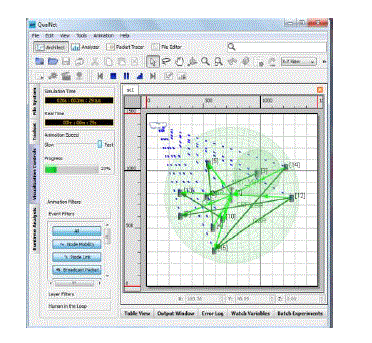 |
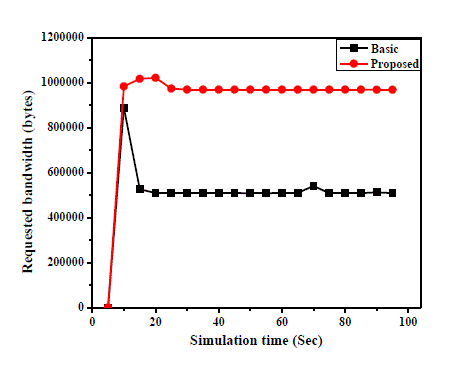 |
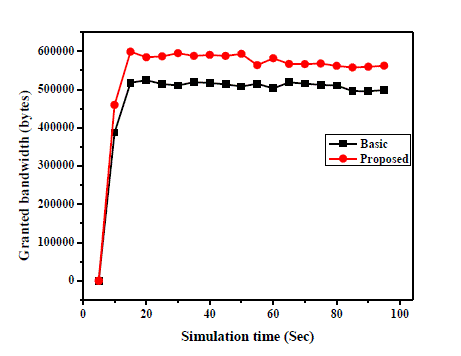 |
| Figure 1 |
Figure 2 |
Figure 3 |
Figure 4 |
Figure 5 |
| |
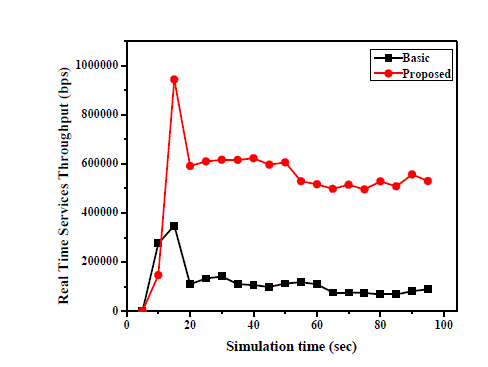 |
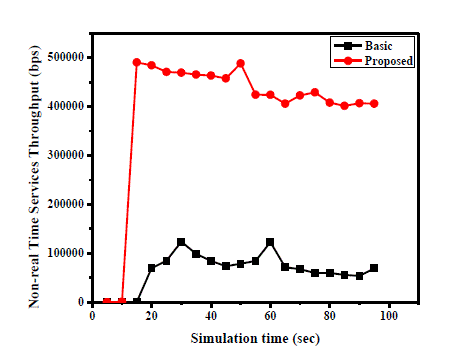 |
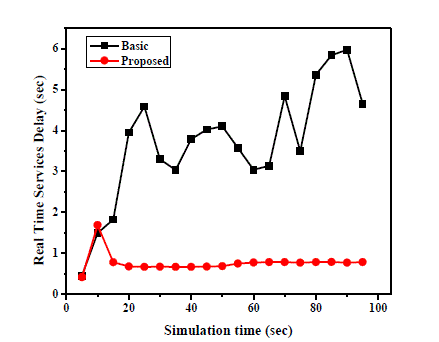 |
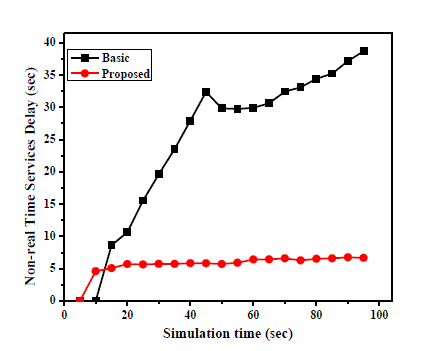 |
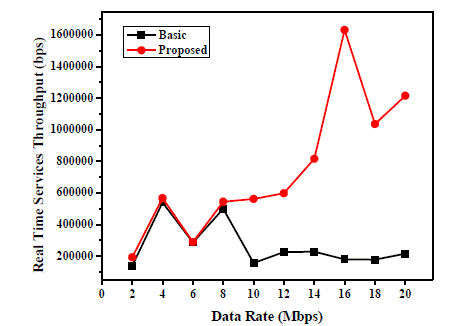 |
| Figure 6 |
Figure 7 |
Figure 8 |
Figure 9 |
Figure 10 |
| |
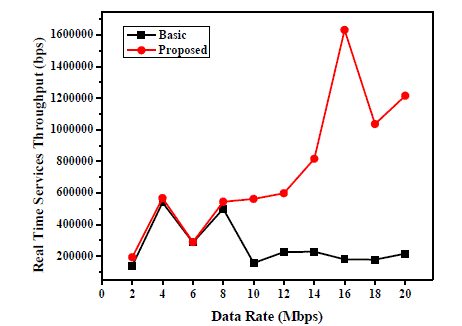 |
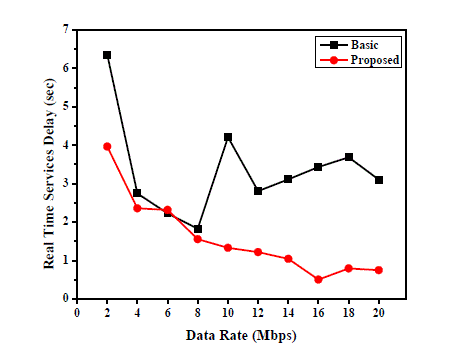 |
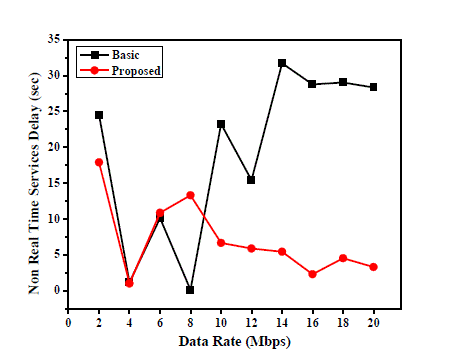 |
| Figure 11 |
Figure 12 |
Figure 13 |
|
| |
References
|
- IEEE Standard 802.16e-2005: Air Interface for Fixed Broadband Wireless Access Systems - Amendment for Physical and Medium ControlLayers for Combined Fixed and Mobile Operation in Licensed Bands.
- IEEE802.16e: IEEE Standard for Local and metropolitan area networks Part 16: Air Interface for Broadband Wireless Access Systems, 2009.
- Byeong Gi Lee and Sunghyun Choi, “Broadband Wireless Access and Local Networks: Mobile WiMAX and WiFi”, Artech House, 2008.
- C. Nie, M. Venkatachalam and X. Yang, “Adaptive polling service for next-generation IEEE 802.16 WiMAX networks”, in Proc.GLOBECOM, pp 4754-4758, 2007.
- Guo Song Chu, Deng Wang and Shunliang Mei, “A QoS architecture for the MAC protocol of IEEE 802.16 BWA system”, IEEE Conferenceon Communications, Circuits and Systems and West Sino Expositions, pp 435-439, 2002.
- B.J. Chang, C.M. C hou and Y.H. Liang, “Markov chain analysis of uplink subframe in polling-based WiMAX networks”, ComputerCommunications, vol. 31, no. 10, pp 2381-2390, 2008.
- Qiang Ni, Alexey Vinel, Yang Xiao, Andrey Turlikov and Tao Jiang, “Investigation of Bandwidth Request Mechanisms under Point-to-Multipoint Mode of WiMAX Networks”, IEEE Communications Magazine, pp 132-138, May 2007.
- H.W Lee and J.B Seo, “Queueing performance of IEEE 802.16 random access protocol with bulk transmissions”, Proceedings of ICC, pp5963-5968, 2007.
- David Chuck, Kuan-Yu Chen and J. Morris Chang, “A Comprehensive Analysis of Bandwidth Request Mechanisms in IEEE 802.16Networks”, IEEE Transactions On Vehicular Technology, Vol. 59, No. 4, pp 2046-2056, May 2010.
- Yaser Pourmohammadi Fallah, Farshid Agharebparast, Mahmood R. Minhas, Hussein M. Alnuweiri and Victor C. M. Leung, “Analytical Modeling of Contention-Based Bandwidth Request Mechanism in IEEE 802.16 Wireless Networks”, IEEE Transactions On VehicularTechnology, Vol. 57, No. 5, pp 3094-3107, September 2008.
- Qiang Ni, Ling Hu, Alexey Vinel, Yang Xiao and Marios Hadjinicolaou, “Performance Analysis of Contention Based Bandwidth RequestMechanisms in WiMAX Networks”, IEEE Systems Journal, Vol. 4, No. 4, December 2010.
- “An Adaptive Bandwidth Request Mechanism for QoS Enhancement in WiMAX Real Time Communication”, L&T Infotech white paper,2008.
- Seungwoon Kim, Minwook Lee, Ikjun Yeom, “Impact of bandwidth request schemes for Best-Effort traffic in IEEE 802.16 networks”,Elsevier Computer Communications, Vol. 32, pp 235-245, 2009.
- Fei Yin, Guy Pujolle, Jong Hyuk Park and Han-Chieh Chao, “Performance Optimization with Efficient Polling Mechanism in IEEE 802.16
- Networks with Cross-Layer Consideration”, Wireless Pers Commun, Vol. 51, 2009.[15] http://www.scalablenetworks.com\qualnet\documentation, Documentation of QualNet simulation tool
|